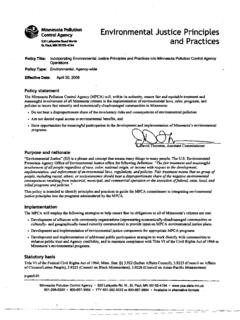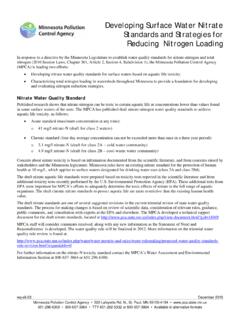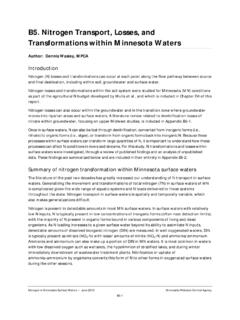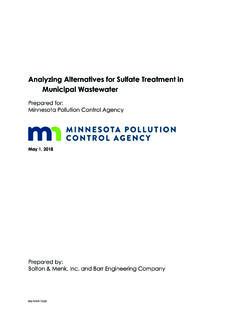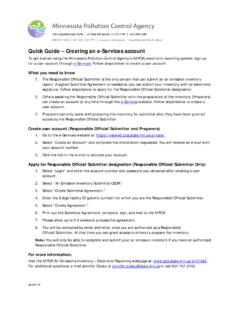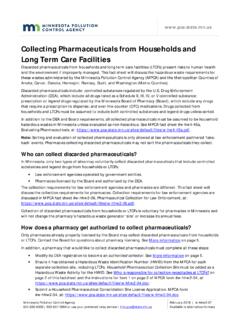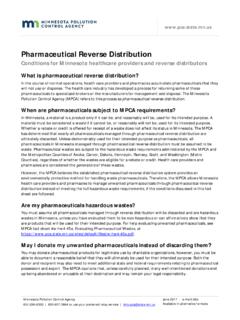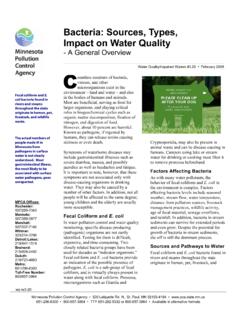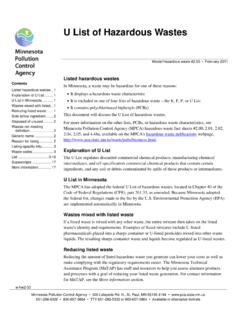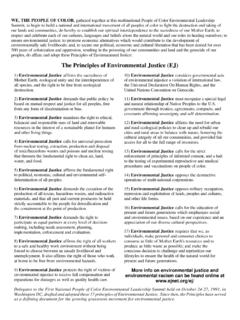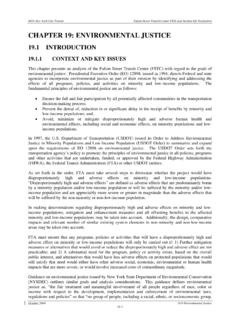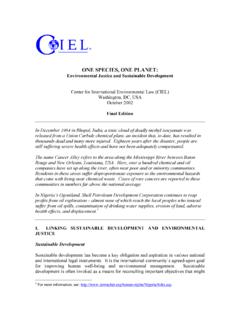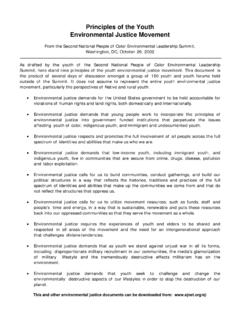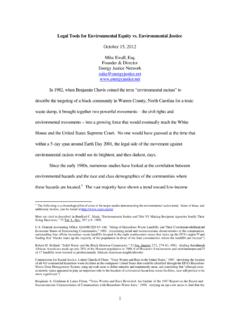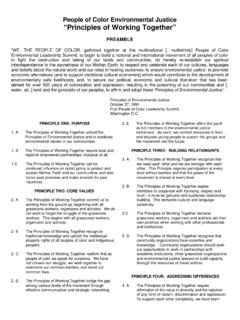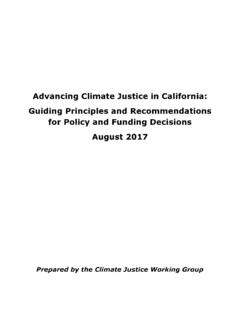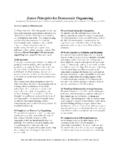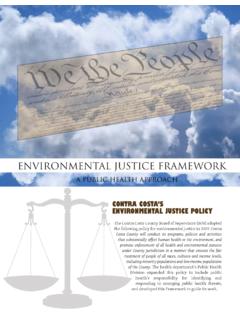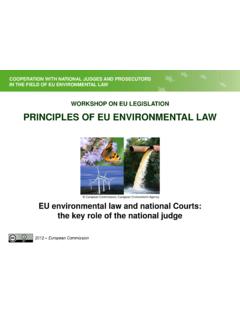Transcription of Environmental Justice Framework Report
1 Environmental Justice Framework December 17, 2015 Minnesota Pollution Control Agency 520 Lafayette Road North | Saint Paul, MN 55155-4194 | 651-296-6300 | 800-657-3864 | Or use your preferred relay service. | This Report is available in alternative formats upon request, and online at Document number: p-gen5-05 Authors Ned Brooks Karen Solas Contributors MPCA Environmental Justice Steering Team: John Linc Stine, Commissioner David Thornton, Assistant Commissioner Dave Benke, Director, Resource Management and Assistance Division Shannon Lotthammer, Director, Environmental Analysis and Outcomes Division Kathy Sather, Director, Remediation Division Jeff Smith, Director, Industrial Division Risikat Adesaogun Taylor Holland Katie Koelfgen Catherine Neuschler Kelsey Suddard Numerous MPCA staff also assisted with development of strategies and approaches.
2 Acknowledgements We are grateful to the many community members, Environmental Justice advocates, and other stakeholders who helped to shape our understanding of the experiences of people impacted by Environmental Justice issues. We thank you for your guidance and input, both invaluable to our work to develop strategies in this Framework . The MPCA is reducing printing and mailing costs by using the Internet to distribute reports and information to wider audience. Visit our website for more information. MPCA reports are printed on 100% post-consumer recycled content paper manufactured without chlorine or chlorine derivatives. Foreword In Minnesota, we are fortunate to live in a state with a healthy natural environment that contributes to a high quality of life. This is in large part due to a long history of shared responsibility and action to build societal systems that support healthy ecosystems, healthy communities, and a strong economy.
3 Not everyone has benefited equally, however, and disparities exist between middle and upper income people, and lower income residents and people of color. These also include gaps in educational and economic achievement and health outcomes that have been widely documented, and in some parts of the state, differences in exposure to Environmental pollution. As Commissioner of the Minnesota Pollution Control Agency, I am committed to renew and strengthen our agency s actions and to put the principles of Environmental Justice into practice. It is with those responsibilities in mind that I am pleased to share with you the Minnesota Pollution Control Agency s Environmental Justice Framework document. This Framework represents our commitment to act using our expertise, relationships, and resources to focus our work where it will have the greatest effect in reducing the impact of Environmental pollution.
4 It provides direction and guidance to modify our practices and integrate Environmental Justice principles into our work over the next two-three years. In collaboration with others, we expect to build on this initial Framework and continually look for ways to improve our implementation of its strategies. Striving to address Environmental inequities across Minnesota is an ambitious and long-term effort. We can only achieve this by working with people, governments, and organizations across the state. Please join us as we strive for a better Minnesota! John Linc Stine Commissioner Contents Summary .. 1 What is the issue? .. 1 What can we do about it? .. 2 MPCA s Environmental Justice policy and plans .. 3 From policy to action MPCA s Environmental Justice Framework .. 3 Strategies for implementing Environmental Justice into MPCA programs .. 6 Regulatory programs.
5 6 Monitoring, assessment, and consideration of cumulative impacts .. 8 Prevention and assistance .. 10 Rulemaking, policy development, and program implementation .. 11 Resources to support Environmental Justice integration .. 12 Screening to identify areas of concern for Environmental Justice .. 12 Outreach, public participation, and engagement .. 13 Agency training and development .. 14 Ongoing stakeholder and community involvement in Framework implementation and improvement .. 14 Coordination with federal, state, local, and tribal governments .. 15 Measuring and reporting on progress .. 16 Environmental Justice Framework December 2015 Minnesota Pollution Control Agency 1 Summary All Minnesotans deserve a life with clean air, clean water, and unpolluted land. Working to achieve this is at the heart of the Minnesota Pollution Control Agency s (MPCA) mission to protect and improve our environment and enhance human health.
6 The MPCA defines Environmental Justice as the fair treatment and meaningful involvement of all people regardless of race, color, national origin, or income with respect to the development, implementation, and enforcement of Environmental laws, regulations, and policies. This will be achieved when everyone benefits from the same degree of Environmental protection and has equal access to the decision-making processes that contribute to a healthy environment. The MPCA is committed to reaching this goal. This document defines strategies and proposes initial implementation actions to integrate Environmental Justice principles into our daily work. Community and stakeholder feedback played a significant role in developing the elements of this Framework . These approaches reflect lessons learned from past experiences as well as stakeholder feedback during 2014 and early 2015. The MPCA fully expects that through experience with implementation, agency staff and stakeholders will identify areas for improvement.
7 As we strive to achieve Environmental Justice , we look forward to collaborating with community members and other stakeholders to refine and improve implementation of this Framework . What is the issue? Over the past 30 years, the MPCA, other units of government, community organizations, businesses, and individuals have come together to significantly reduce air and water pollution and clean up contaminated sites. Many of these improvements are the result of reducing emissions from large sources of pollution using traditional regulatory methods -- issuing permits that limit pollution and ensuring sources comply with Environmental laws. Other improvements have been achieved by addressing pollution from smaller more widespread sources, which are often more difficult to control. Because of this work, most Minnesotans enjoy a natural environment that contributes to a high quality of life.
8 But not all Minnesotans have benefitted in the same way. The impacts of pollution vary across Minnesota because of past practices and decisions. Historical settlement patterns of low-income workers who lived near the factories where they worked; the routing of roadways and the siting of industry in low-income neighborhoods or within communities of color, created inequities in exposures and health conditions. For example: Low-income Minnesotans and people of color in some parts of the state are exposed to more pollution than middle and upper income white Minnesotans. Older residents, children, many lower income Minnesotans, and people of color are more vulnerable to health impacts from pollution and experience greater incidences of disease and death, often due to underlying health disparities. Climate change disproportionately threatens vulnerable groups and can amplify the economic and health challenges people already face.
9 The MPCA and other government agencies decision making processes too often lack adequate opportunities and access for those facing Environmental Justice challenges. Traditional approaches can be inconvenient, hard to follow and understand, one-sided, and lack community and cultural sensitivity. This further inhibits participation and affects trust, making it less likely for people to feel their involvement in a government process will have an impact. Environmental Justice Framework December 2015 Minnesota Pollution Control Agency 2 Minnesota s changing racial and ethnic demographics requires the MPCA to adapt. In 1980, people of color accounted for only 4% of Minnesota s population. Now, while still below the national average, that figure is about 18%. In the past decade, only six other states populations of people of color grew faster. Migrants from other countries and new births to immigrants and native-born communities of color contributed significantly to Minnesota s population growth in recent years.
10 Those new to Minnesota face a unique set of barriers to full participation, ranging from language and communication methods to different cultures and customs. What can we do about it? Fully addressing disparities in Environmental exposures and effects requires the combined and concerted efforts of many partners: federal, state, and local governments; non-profit and community organizations; universities; businesses; and community members. While we don t have the ability to address all aspects of this issue on our own, we are committed to using our authority and influence to address past inequities and to prevent Environmental policies and decisions from producing future disproportionate impacts. It is important we recognize and embrace our role and partner with, facilitate, and support others in doing their part. This Framework provides MPCA leadership and staff with the direction and guidance needed to modify our approaches and integrate Environmental Justice principles into the Agency s work.
